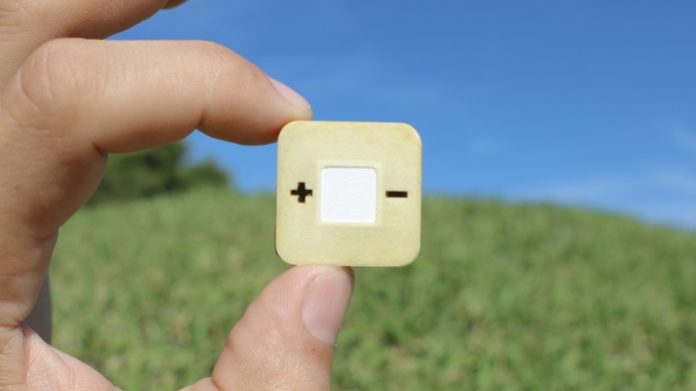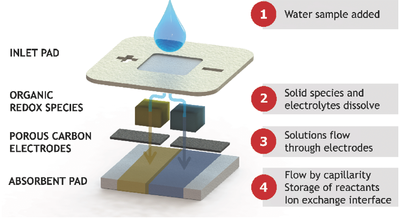It doesn’t look very impressive – a tiny, almost flat square of paper just one inch across – but the PowerPAD is capable of providing instant power for up to 100 minutes and is completely biodegradable. The device is described in the May issue of Advanced Energy Materials.
A meeting of minds
The PowerPAD, short for Power: Portable and Disposable, was developed by Professor Erik Kjeang at Simon Fraser University in collaboration with researchers from the Instituto de Microelectronica de Barcelona in Spain. Kjeang met his two Spanish colleagues, Neus Sabaté and Juan Pablo Esquivel, two years ago at the Science for Solving Society’s Problems Challenge sponsored by the Bill and Melinda Gates Foundation and hosted by the Electrochemical Society. They came up with the idea for the PowerPAD on day one while discussing their research and immediately became collaborators.
“We only had about two days to come up with a mini-proposal, and another 24 hours or so to prepare a 2-minute live pitch to a panel of judges,” says Kjeang.
The next day, the project won a $50,000 prize.
Use it and lose it
The PowerPAD is actually a tiny flow-cell battery made entirely out of organic materials. Layers of patterned cellulose soaked in beeswax define microscopic flow paths and compartments that contain the carbon electrodes and electrochemical reagents.
Schematic of the PowerPAD biodegradable battery. Advanced Energy Materials 16 MAY 2017 DOI: 10.1002/aenm.201700275. Used under a CC 4.0 license.
The device is activated with a few drops of water, which get sucked inside by capillary action, the same way a paper napkin sucks up liquid. The water activates the electrochemical reagents inside the device, producing power at 1.5 to 3.0 volts for up to 100 minutes. When it’s done, just throw it away where it will degrade into harmless products.
Metal-free
Since 100 minutes is not a very long time compared to standard AA batteries, biodegradability is currently the PowerPAD’s major selling point. AA batteries are dry-cell batteries that rely on metals like zinc, nickel, lithium, or cadmium to produce their electrochemical energy.
After disposal and once the battery casing rusts away, these metals leach into the ground and eventually end up in our water supply. That’s why you should always dispose of batteries through special collection programs where they can be sorted by chemistry and melted down to make new products
In contrast, the PowerPAD uses quinone-based electrochemistry to generate power. Quinones are a class of organic compounds characterized by ring structures and a network of double bonds. It’s this network that makes them good charge carriers, as extra electrons are shared across many atoms. Quinones also occur naturally in many organisms including humans. You might have heard of ubiquinone also known as coenzyme Q10, a vital component of cellular energy production (although it is also marketed as an active component of anti-wrinkle cream).
Solving society’s problems
For Kjeang, who is Director of the SFU Fuel Cell Research Laboratory (FCReL) and the newly appointed Canada Research Chair in Fuel Cell Science and Technology Development, the project was a natural extension of his desire to create more efficient fuel cells. He imagines that the PowerPAD could be used for everyday needs, but also envisions its use in emergency situations such as natural disasters or for providing power to remote areas of the globe.
“Prototypes have been developed that can directly replace a coin cell battery and power water quality monitoring systems,” says Kjeang.
The team is now actively looking for industry partners to help commercialize the technology.









































